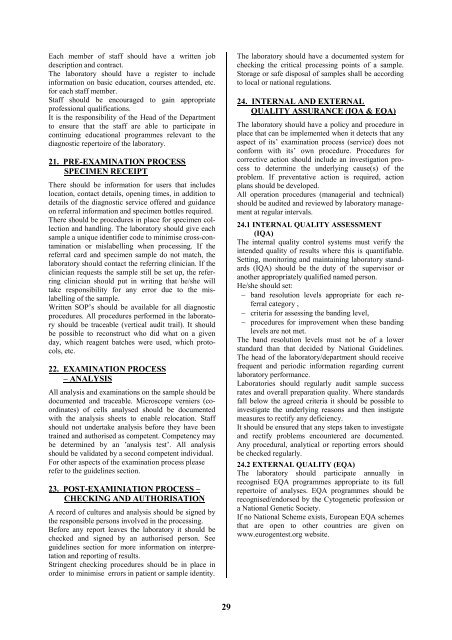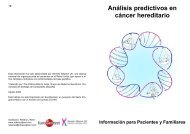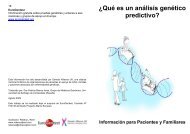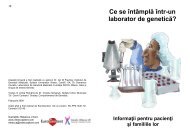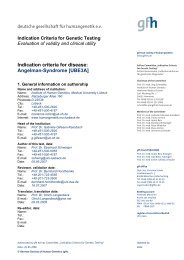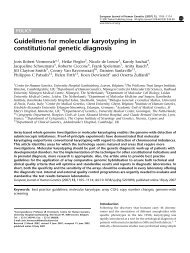Cytogenetic Guidelines and Quality Assurance - EuroGentest
Cytogenetic Guidelines and Quality Assurance - EuroGentest
Cytogenetic Guidelines and Quality Assurance - EuroGentest
You also want an ePaper? Increase the reach of your titles
YUMPU automatically turns print PDFs into web optimized ePapers that Google loves.
Each member of staff should have a written job<br />
description <strong>and</strong> contract.<br />
The laboratory should have a register to include<br />
information on basic education, courses attended, etc.<br />
for each staff member.<br />
Staff should be encouraged to gain appropriate<br />
professional qualifications.<br />
It is the responsibility of the Head of the Department<br />
to ensure that the staff are able to participate in<br />
continuing educational programmes relevant to the<br />
diagnostic repertoire of the laboratory.<br />
21. PRE-EXAMINATION PROCESS<br />
SPECIMEN RECEIPT<br />
There should be information for users that includes<br />
location, contact details, opening times, in addition to<br />
details of the diagnostic service offered <strong>and</strong> guidance<br />
on referral information <strong>and</strong> specimen bottles required.<br />
There should be procedures in place for specimen collection<br />
<strong>and</strong> h<strong>and</strong>ling. The laboratory should give each<br />
sample a unique identifier code to minimise cross-contamination<br />
or mislabelling when processing. If the<br />
referral card <strong>and</strong> specimen sample do not match, the<br />
laboratory should contact the referring clinician. If the<br />
clinician requests the sample still be set up, the referring<br />
clinician should put in writing that he/she will<br />
take responsibility for any error due to the mislabelling<br />
of the sample.<br />
Written SOP’s should be available for all diagnostic<br />
procedures. All procedures performed in the laboratory<br />
should be traceable (vertical audit trail). It should<br />
be possible to reconstruct who did what on a given<br />
day, which reagent batches were used, which protocols,<br />
etc.<br />
22. EXAMINATION PROCESS<br />
– ANALYSIS<br />
All analysis <strong>and</strong> examinations on the sample should be<br />
documented <strong>and</strong> traceable. Microscope verniers (coordinates)<br />
of cells analysed should be documented<br />
with the analysis sheets to enable relocation. Staff<br />
should not undertake analysis before they have been<br />
trained <strong>and</strong> authorised as competent. Competency may<br />
be determined by an ’analysis test’. All analysis<br />
should be validated by a second competent individual.<br />
For other aspects of the examination process please<br />
refer to the guidelines section.<br />
23. POST-EXAMINIATION PROCESS –<br />
CHECKING AND AUTHORISATION<br />
A record of cultures <strong>and</strong> analysis should be signed by<br />
the responsible persons involved in the processing.<br />
Before any report leaves the laboratory it should be<br />
checked <strong>and</strong> signed by an authorised person. See<br />
guidelines section for more information on interpretation<br />
<strong>and</strong> reporting of results.<br />
Stringent checking procedures should be in place in<br />
order to minimise errors in patient or sample identity.<br />
29<br />
The laboratory should have a documented system for<br />
checking the critical processing points of a sample.<br />
Storage or safe disposal of samples shall be according<br />
to local or national regulations.<br />
24. INTERNAL AND EXTERNAL<br />
QUALITY ASSURANCE (IQA & EQA)<br />
The laboratory should have a policy <strong>and</strong> procedure in<br />
place that can be implemented when it detects that any<br />
aspect of its’ examination process (service) does not<br />
conform with its’ own procedure. Procedures for<br />
corrective action should include an investigation process<br />
to determine the underlying cause(s) of the<br />
problem. If preventative action is required, action<br />
plans should be developed.<br />
All operation procedures (managerial <strong>and</strong> technical)<br />
should be audited <strong>and</strong> reviewed by laboratory management<br />
at regular intervals.<br />
24.1 INTERNAL QUALITY ASSESSMENT<br />
(IQA)<br />
The internal quality control systems must verify the<br />
intended quality of results where this is quantifiable.<br />
Setting, monitoring <strong>and</strong> maintaining laboratory st<strong>and</strong>ards<br />
(IQA) should be the duty of the supervisor or<br />
another appropriately qualified named person.<br />
He/she should set:<br />
b<strong>and</strong> resolution levels appropriate for each referral<br />
category ,<br />
criteria for assessing the b<strong>and</strong>ing level,<br />
procedures for improvement when these b<strong>and</strong>ing<br />
levels are not met.<br />
The b<strong>and</strong> resolution levels must not be of a lower<br />
st<strong>and</strong>ard than that decided by National <strong>Guidelines</strong>.<br />
The head of the laboratory/department should receive<br />
frequent <strong>and</strong> periodic information regarding current<br />
laboratory performance.<br />
Laboratories should regularly audit sample success<br />
rates <strong>and</strong> overall preparation quality. Where st<strong>and</strong>ards<br />
fall below the agreed criteria it should be possible to<br />
investigate the underlying reasons <strong>and</strong> then instigate<br />
measures to rectify any deficiency.<br />
It should be ensured that any steps taken to investigate<br />
<strong>and</strong> rectify problems encountered are documented.<br />
Any procedural, analytical or reporting errors should<br />
be checked regularly.<br />
24.2 EXTERNAL QUALITY (EQA)<br />
The laboratory should participate annually in<br />
recognised EQA programmes appropriate to its full<br />
repertoire of analyses. EQA programmes should be<br />
recognised/endorsed by the <strong>Cytogenetic</strong> profession or<br />
a National Genetic Society.<br />
If no National Scheme exists, European EQA schemes<br />
that are open to other countries are given on<br />
www.eurogentest.org website.


